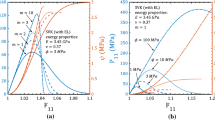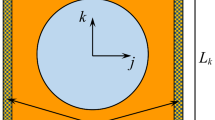Abstract
An accelerated micromechanics framework based on the extended Mori–Tanaka transformation field analysis (TFA) and cycle jump technique is proposed to predict the homogenized response of short glass fiber-reinforced polyamide 66 composites (PA66/GF) under a large number of loading cycles (> 100,000 cycles). The extended theory accounts for microscopic viscoelastic–viscoplastic and damage mechanisms, and realistic microstructures induced by the injection molding process. Toward this end, a number of training cycles are first conducted using the extended Mori–Tanaka TFA to obtain the global evolution functions of material state-dependent variables (SDVs) for each phase. These SDVs are extrapolated linearly to a certain jump length with the help of global evolution functions such that direct numerical simulation of the cycles during this interval can be skipped, leading to a large computational cost reduction. After the cycle jump, a set of complete cycles are performed based on the extrapolated SDVs using the Mori–Tanaka TFA simulation to re-establish the global evolution functions. The implementation of the cycle jump procedure is facilitated by introducing an extrapolation control function to allow adaptive jump size control as well as to minimize the extrapolating error. The capabilities of the extended theory with the cycle jump technique have been validated extensively vis-à-vis cycle-by-cycle benchmark calculations under various loading conditions. It has been further verified with the experimental results of actual PA66/GF composites under high-cycle loading beyond which the cycle-by-cycle simulations can achieve.














Similar content being viewed by others
References
Gajek, S., Schneider, M., Böhlke, T.: An FE-DMN method for the multiscale analysis of thermomechanical composites. Comput. Mech. 69, 1087–1113 (2022)
Dinzart, F., Torres-Costa, L.M., Sabar, H.: New micromechanical model in time domain for linear viscoelastic composites with ellipsoidal reinforcements. Acta Mech. 233, 2009–2029 (2022)
Görthofer, J., Schneider, M., Hrymak, A., Böhlke, T.: A computational multiscale model for anisotropic failure of sheet molding compound composites. Compos. Struct. 288, 115322 (2022)
Santharam, P., Marco, Y., Le Saux, V., Le Saux, M., Robert, G., Raoult, I., et al.: Fatigue criteria for short fiber-reinforced thermoplastic validated over various fiber orientations, load ratios and environmental conditions. Int. J. Fatigue 135, 105574 (2020)
Arif, M.F., Saintier, N., Meraghni, F., Fitoussi, J., Chemisky, Y., Robert, G.: Multiscale fatigue damage characterization in short glass fiber reinforced polyamide-66. Compos. B Eng. 61, 55–65 (2014)
Tu, W., Chen, Q.: Evolution of interfacial debonding of a unidirectional graphite/polyimide composite under off-axis loading. Eng. Fract. Mech. 230, 106947 (2020)
Russo, A., Riccio, A., Sellitto, A.: A robust cumulative damage approach for the simulation of delamination under cyclic loading conditions. Compos. Struct. 281, 114998 (2022)
Bian, L., Cheng, Y., Taheri, F.: Elasto-plastic analysis of critical fracture stress and fatigue fracture prediction. Acta Mech. 225, 3059–3072 (2014)
Qin, D.-W., Ju, J.W., Zhang, K.-S., Li, Z.-S.: Inhomogeneous deformation growth of a metal under cyclic loading and its influence on fatigue. Acta Mech. 231, 701–713 (2020)
Chen, Q., Chatzigeorgiou, G., Robert, G., Meraghni, F.: Viscoelastic-viscoplastic homogenization of short glass-fiber reinforced polyamide composites (PA66/GF) with progressive interphase and matrix damage: New developments and experimental validation. Mech. Mater. 164, 104081 (2022)
Hessman, P.A., Riedel, T., Welschinger, F., Hornberger, K., Böhlke, T.: Microstructural analysis of short glass fiber reinforced thermoplastics based on x-ray micro-computed tomography. Compos. Sci. Technol. 183, 107752 (2019)
Arif, M.F., Meraghni, F., Chemisky, Y., Despringre, N., Robert, G.: In situ damage mechanisms investigation of PA66/GF30 composite: effect of relative humidity. Compos. B Eng. 58, 487–495 (2014)
Pindera, M.-J., Khatam, H., Drago, A.S., Bansal, Y.: Micromechanics of spatially uniform heterogeneous media: a critical review and emerging approaches. Compos. B Eng. 40, 349–378 (2009)
Saeb, S., Steinmann, P., Javili, A.: Aspects of computational homogenization at finite deformations: a unifying review from Reuss’ to Voigt’s bound. Appl. Mech. Rev. 68, 050801 (2016)
Chen, Q., Wang, G., Pindera, M.-J.: Homogenization and localization of nanoporous composites—a critical review and new developments. Compos. B Eng. 155, 329–368 (2018)
He, Z.: Finite volume based asymptotic homogenization of viscoelastic unidirectional composites. Compos. Struct. 291, 115601 (2022)
Schneider, M.: A review of nonlinear FFT-based computational homogenization methods. Acta Mech. 232, 2051–2100 (2021)
Zhi, J., Poh, L.H., Tay, T.-E., Tan, V.B.C.: Direct FE2 modeling of heterogeneous materials with a micromorphic computational homogenization framework. Comput. Methods Appl. Mech. Eng. 393, 114837 (2022)
Chen, Q., Chatzigeorgiou, G., Meraghni, F., Javili, A.: Homogenization of size-dependent multiphysics behavior of nanostructured piezoelectric composites with energetic surfaces. Eur. J. Mech. A. Solids 96, 104731 (2022)
Chen, Q., Wang, G., Chen, X., Geng, J.: Finite-volume homogenization of elastic/viscoelastic periodic materials. Compos. Struct. 182, 457–470 (2017)
He, Z., Pindera, M.-J.: Finite volume based asymptotic homogenization theory for periodic materials under anti-plane shear. Eur. J. Mech. A. Solids 85, 104122 (2021)
Chen, Q., Pindera, M.-J.: Homogenization and localization of elastic-plastic nanoporous materials with Gurtin-Murdoch interfaces: an assessment of computational approaches. Int. J. Plast 124, 42–70 (2020)
Hessman, P.A., Welschinger, F., Hornberger, K., Böhlke, T.: On mean field homogenization schemes for short fiber reinforced composites: unified formulation, application and benchmark. Int. J. Solids Struct. 230–231, 111141 (2021)
Barral, M., Chatzigeorgiou, G., Meraghni, F., Léon, R.: Homogenization using modified Mori–Tanaka and TFA framework for elastoplastic-viscoelastic–viscoplastic composites: theory and numerical validation. Int. J. Plast 127, 102632 (2020)
Haddad, M., Doghri, I., Pierard, O.: Viscoelastic-viscoplastic polymer composites: development and evaluation of two very dissimilar mean-field homogenization models. Int. J. Solids Struct. 236–237, 111354 (2022)
Chen, Q., Chatzigeorgiou, G., Meraghni, F.: Extended mean-field homogenization of viscoelastic–viscoplastic polymer composites undergoing hybrid progressive degradation induced by interface debonding and matrix ductile damage. Int. J. Solids Struct. 210–211, 1–17 (2021)
Praud, F., Chatzigeorgiou, G., Bikard, J., Meraghni, F.: Phenomenological multi-mechanisms constitutive modelling for thermoplastic polymers, implicit implementation and experimental validation. Mech. Mater. 114, 9–29 (2017)
Troshchenko, V., Yasnii, P., Pokrovskii, V.: Calculation of fatigue and life of crack-bearing structural elements under cyclic load. Strength Mater. 14, 1434–1439 (1982)
Lesne, P.-M., Savalle, S.: An efficient cycles jump technique for viscoplastic structure calculations involving large number of cycles. ONERA, TP no 1989–138. 1989:13.
Abdul-Latif, A., Razafindramary, D., Rakotoarisoa, J.C.: New hybrid cycle jump approach for predicting low-cycle fatigue behavior by a micromechanical model with the damage induced anisotropy concept. Int. J. Mech. Sci. 160, 397–411 (2019)
Loew, P.J., Poh, L.H., Peters, B., Beex, L.A.A.: Accelerating fatigue simulations of a phase-field damage model for rubber. Comput. Methods Appl. Mech. Eng. 370, 113247 (2020)
Titscher, T., Unger, J.F.: Efficient higher-order cycle jump integration of a continuum fatigue damage model. Int. J. Fatigue 141, 105863 (2020)
Cojocaru, D., Karlsson, A.M.: A simple numerical method of cycle jumps for cyclically loaded structures. Int. J. Fatigue 28, 1677–1689 (2006)
Van Paepegem, W., Degrieck, J., De Baets, P.: Finite element approach for modelling fatigue damage in fibre-reinforced composite materials. Compos. B Eng. 32, 575–588 (2001)
Van Paepegem, W., Degrieck, J.: Fatigue degradation modelling of plain woven glass/epoxy composites. Compos. A Appl. Sci. Manuf. 32, 1433–1441 (2001)
Fish, J., Bailakanavar, M., Powers, L., Cook, T.: Multiscale fatigue life prediction model for heterogeneous materials. Int. J. Numer. Meth. Eng. 91, 1087–1104 (2012)
Lüders, C., Sinapius, M., Krause, D.: Adaptive cycle jump and limits of degradation in micromechanical fatigue simulations of fibre-reinforced plastics. Int. J. Damage Mech. 28, 1523–1555 (2019)
Sally, O., Laurin, F., Julien, C., Desmorat, R., Bouillon, F.: An efficient computational strategy of cycle-jumps dedicated to fatigue of composite structures. Int. J. Fatigue 135, 105500 (2020)
Dvorak, G.J.: Transformation field analysis of inelastic composite materials. Proc. R. Soc. Lond. A 437, 311–327 (1992)
Dvorak, G.J., Benveniste, Y.: On transformation strains and uniform fields in multiphase elastic media. Proc. R. Soc. Lond. A 437, 291–310 (1992)
Eshelby, J.D.: The determination of the elastic field of an ellipsoidal inclusion, and related problems. Proc. R. Soc. Lond. A 241, 376–396 (1957)
Mura, T.: Mechanics of Elastic and Inelastic Solids. Micromechanics of Defects in Solids. Martinus Nijhoff Publishers, Dordrecht (1987)
Gavazzi, A., Lagoudas, D.: On the numerical evaluation of Eshelby’s tensor and its application to elastoplastic fibrous composites. Comput. Mech. 7, 13–19 (1990)
Lemaitre, J., Chaboche, J.-L.: Mechanics of Solid Materials. Cambridge University Press, Cambridge (1994)
Praud, F., Chatzigeorgiou, G., Chemisky, Y., Meraghni, F.: Hybrid micromechanical-phenomenological modelling of anisotropic damage and anelasticity induced by micro-cracks in unidirectional composites. Compos. Struct. 182, 223–236 (2017)
Chatzigeorgiou, G., Charalambakis, N., Chemisky, Y., Meraghni, F.: Computational Methods. In: Chatzigeorgiou, G., Charalambakis, N., Chemisky, Y., Meraghni, F. (eds.) Thermomechanical Behavior of Dissipative Composite Materials, pp. 89–116. Elsevier, Amsterdam (2017)
Chatzigeorgiou, G., Meraghni, F., Charalambakis, N.: Chapter 12—Nonlinear composites. In: Chatzigeorgiou, G., Meraghni, F., Charalambakis, N., (eds), Multiscale Modeling Approaches for Composites: Elsevier, pp. 299–324 (2022)
Lemaitre, J.: Coupled elasto-plasticity and damage constitutive equations. Comput. Methods Appl. Mech. Eng. 51, 31–49 (1985)
Detrez, F., Cantournet, S., Seguela, R.: Plasticity/damage coupling in semi-crystalline polymers prior to yielding: micromechanisms and damage law identification. Polymer 52, 1998–2008 (2011)
Krairi, A., Doghri, I.: A thermodynamically-based constitutive model for thermoplastic polymers coupling viscoelasticity, viscoplasticity and ductile damage. Int. J. Plast 60, 163–181 (2014)
Author information
Authors and Affiliations
Corresponding author
Additional information
Publisher's Note
Springer Nature remains neutral with regard to jurisdictional claims in published maps and institutional affiliations.
Rights and permissions
Springer Nature or its licensor (e.g. a society or other partner) holds exclusive rights to this article under a publishing agreement with the author(s) or other rightsholder(s); author self-archiving of the accepted manuscript version of this article is solely governed by the terms of such publishing agreement and applicable law.
About this article
Cite this article
Chen, Q., Chatzigeorgiou, G., Robert, G. et al. Combination of mean-field micromechanics and cycle jump technique for cyclic response of PA66/GF composites with viscoelastic–viscoplastic and damage mechanisms. Acta Mech 234, 1533–1552 (2023). https://doi.org/10.1007/s00707-022-03448-4
Received:
Revised:
Accepted:
Published:
Issue Date:
DOI: https://doi.org/10.1007/s00707-022-03448-4




